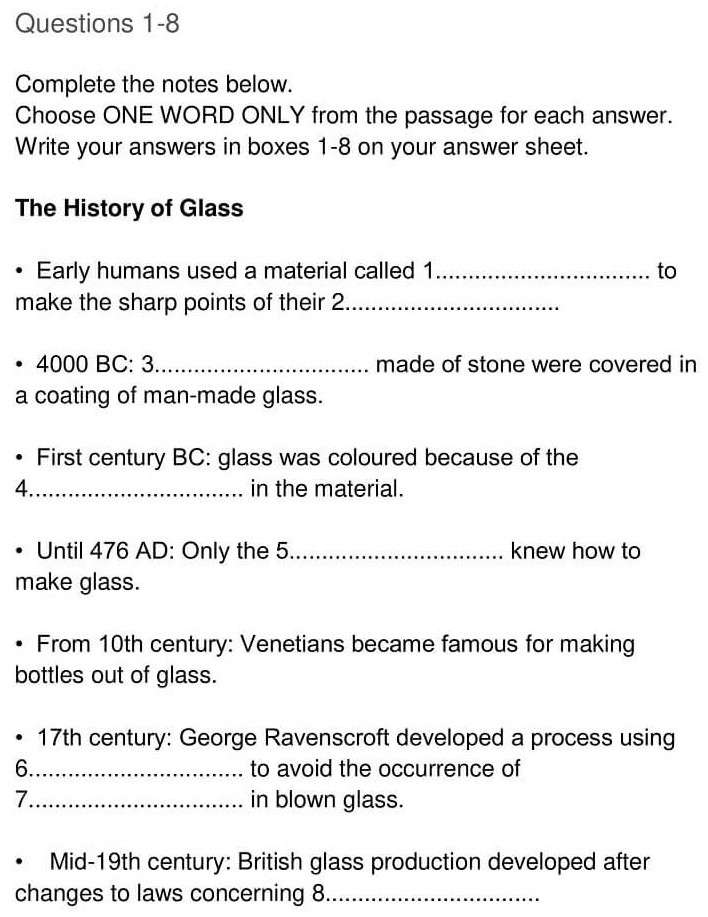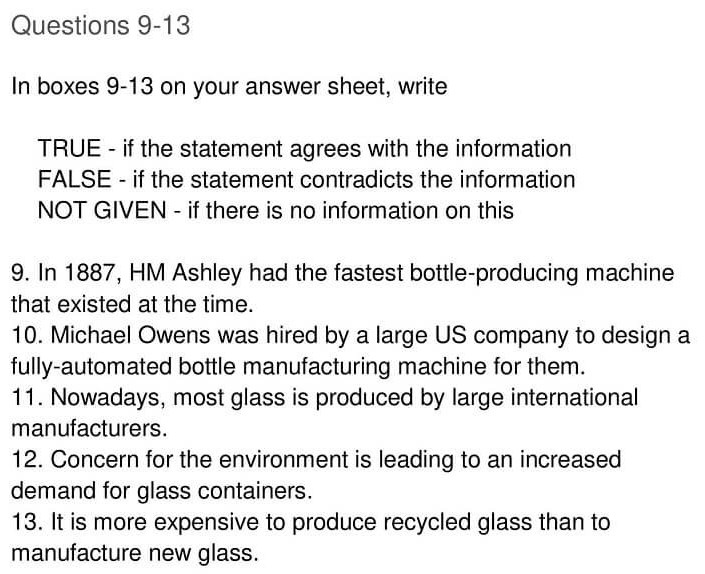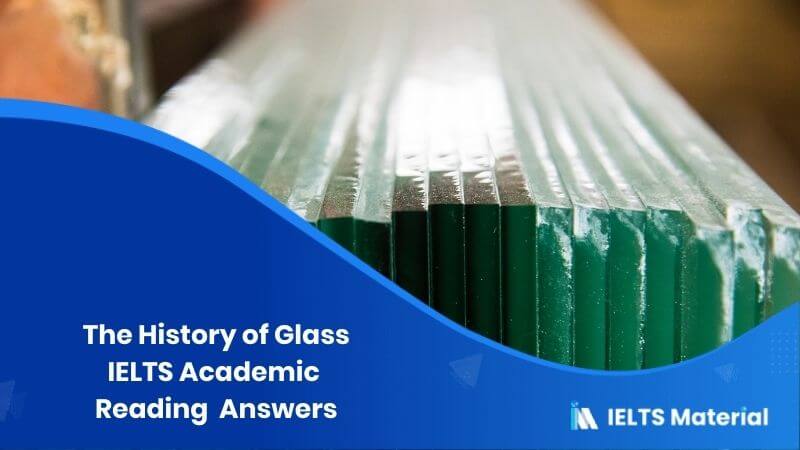IELTS Academic Reading ‘The History of Glass’ Answers
6 min read
Updated On
-
Copy link
Table of Contents

Limited-Time Offer : Access a FREE 10-Day IELTS Study Plan!
The IELTS Academic Reading: Cambridge Reading Sample; ‘The History of Glass’ with answers. The post will discuss the answers to questions 1-13. The headline of the passage is ‘The History of Glass’
The History of Glass





Answers
Unlock Answers
| Question Number | Answer | Explanation |
|---|---|---|
| 1 | Obsidian | The answer for the question is mentioned in the first paragraph that Man has been making glass from the early days. The historians discovered it to be a type of natural glass, Obsidian. So, the answer is Obsidian. |
| 2 | Spears | It is mentioned in the first paragraph that a type of natural glass, Obsidian, was discovered and formed in places such as the mouth of a volcano as a result of the intense heat of an eruption melting sand. The Obsidian was first used as a tip for spears. Here, used means to make and sharp points refer to the tips. Thus, the answer is Spears. |
| 3 | Beads | In the sixth line of the first paragraph, it is described that in 4000 BC, Archaeologists found evidence of man-made glass, which took the form of glazes used for coating stone beads. So, as per the question, the first thing to be made of stone was beads, covered in a coating of man-made glass. So, the answer is Beads. |
| 4 | Impurities | In the third line of the second paragraph, it is mentioned that due to the impurities of the raw material, the glasses made in the first century BC were highly coloured. So, according to the question, the impurities in the raw material led to the colouring of the glasses. Here, highly coloured means colourful. So, the answer is Impurities. |
| 5 | Romans | The answer to the question can be located in the second paragraph, where it is mentioned that the secret of glassmaking was taken across Europe by the Romans during this century. However, they guarded the skills and technology required to make glass very closely. It was not until their empire collapsed in 476 AD that glassmaking knowledge became widespread throughout Europe and the Middle East. We understand from the above lines that until the collapse of the Roman Court in 476 AD, only the Romans knew how to make the glasses. So, the answer is Romans. |
| 6 | Lead | We can find the reference of the name George Ravenscroft in the third paragraph. So, most probably, the answer can be traced in the 3rd paragraph. It is mentioned that George attempted to counter the effects of clouding that sometimes occurred in blown glass by introducing Lead to the raw materials used in the process. Here, we can understand that George used Lead in the raw material and developed a process. So, the answer is Lead. |
| 7 | Clouding | The answer can be located in the second line of the 3rd paragraph that George attempted to counter the effect of clouding that sometimes occurs in blown glass with the introduction of Lead in the raw materials. So, as per the question, to avoid means to counter, we can understand from these lines that George used Lead to develop a process so that clouding can be avoided. Thus, the answer is Clouding. |
| 8 | Taxes | In paragraph 4, it is mentioned that in Britain, the modern glass industry only really started to develop after the repeal of the Excise Act in 1845. Before that time, heavy taxes had been placed on the amount of glass melted in a glasshouse and were levied continuously from 1746 to 1845. So, it can be understood from the above lines that in the mid 19th century (1746-1845), glass production in Britain was a problem when heavy taxes were placed on the glass blowing industry. Only after the repeal of The Excise Act in 1845, the industry began to develop. Thus, the answer is Taxes. |
| 9 | True | We can locate the answer in the fifth paragraph, where it is mentioned that HM Ashley introduced a machine capable of producing 200 bottles per hour in Castleford, Yorkshire, and England, three times quicker than any previous production method. Thus, these lines suggest that HM Ashley had the fastest bottle producing machine that existed during that time. So, the answer is True. |
| 10 | False | As per the question, the answer can be found in the fifth paragraph, where it is mentioned that in 1907, the first fully automated machine was developed in the USA by Michael Owens, founder of Owens Bottle Machine Company, (later the major manufacturer Owen’s-Illinois) and installed in its factory. These lines clearly suggest that Michael Owens was the founder of a large US company. He was not hired by anyone. Here, founder means owner. So, the answer is False. |
| 11 | Not Given | According to the question, we find references to the answer in paragraph 6, where it is narrated that today, glass manufacturing is a big business. However, it is not mentioned anywhere in the passage that whether most glass is produced by large international manufacturers or not. Since enough information is not found the answer is NOT GIVEN. |
| 12 | True | The answer can be found in paragraph 7, which states that glass is an ideal material, and with growing consumer concerns for green issues, glass bottles and jars are becoming even more popular. We understand from these lines that the consumers are worried about the environmental issues (green issues), leading to glass production being even more popular. Here, popular refers to increasing demand and green issues means environmental issues. Thus, the statement agrees with the information. As a result, the answer is True. |
| 13 | False | In paragraph 7, it is mentioned that as less energy is needed to melt recycled glass than to melt down raw materials, this also saves fuel and production costs. We understand from these lines that recycled glass production saves money and is cost-effective, which means less expensive. So, the answer is False. |
Check More IELTS Reading Answers
| Educating Psyche Answers | Endless Harvest Answers |
| Glass Capturing The Dance Of Light Answers | The Nature Of Genius Answers |
| The Rocket From East To West Answers | Trees In Trouble Answers |
Also check :
Practice IELTS Academic Reading based on question types

Start Preparing for IELTS: Get Your 10-Day Study Plan Today!
Recent Articles

Kasturika Samanta

Nehasri Ravishenbagam

Nehasri Ravishenbagam

Kasturika Samanta




Post your Comments